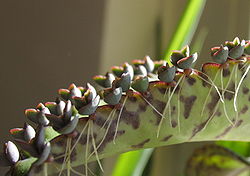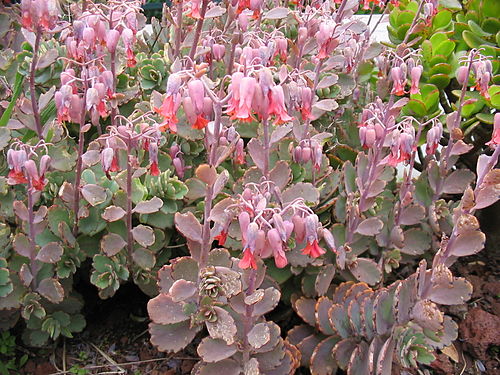Kalanchoe sect. Bryophyllum
| Habit | cacti-succulent |
|---|
If this plant info box on watering; zones; height; etc. is mostly empty you can click on the edit tab and fill in the blanks!
The Bryophyllums (from the Greek sprout-leaf) are a section in the plant genus Kalanchoe of the Crassulaceae family. There are about twenty to thirty species in the group, native originally of South Africa, Madagascar, and Asia. The group is notable for vegetatively growing small plantlets on the fringes of the leaves; these eventually drop off and root. These plantlets arise from mitosis of meristematic-type tissue in notches in the leaves.
Nowadays, bryophyllums are naturalised in many parts of the tropics, either deliberately cultivated originally for their attractiveness and interesting reproduction. Some species are toxic, containing plant acids, bufadienolide alkaloids,[1] calcium oxalate etc, and have become noxious weeds in parts of the world. In the native range of some of these Kalanchoe species in the Karroo region of South Africa, they are abundant enough that they cause disease in livestock, known as krimpsiekte ("shrinking disease") or as cotyledonosis.[2]
There are many hybrids, e.g. Kalanchoe × crenatodaigremontiana (K. crenata × K. daigremontiana) or Houghton's Hybrid (B.daigremontianum × B.delagoensis).
Read about Kalanchoe sect. Bryophyllum in the Standard Cyclopedia of Horticulture
|
|---|
|
Bryophyllum (Greek, sprouting leaf). Crassulaceae. A small genus of succulent plants in the same order with stonecrops, hen-and-chickens, cotyledon and echeveria, grown to some extent as flowering plants but more especially as a foliage novelty. Root-system fibrous and very abundant: sts. upright, simple or sometimes branching toward the base, of a thick soft tissue over a woody cylindrical core: Lvs. opposite, petioled, simple or pinnately compound, succulent: inn. cymose or paniculate; fls. nodding; sepals 4, united into an inflated calyx which incloses the lower half or more of the corolla; corolla cylindrical, ending in 4 petal tips; stamens 8; ovaries 4, separate or more or less united below. The members of this genus may readily be distinguished from related genera by the "sprouting" habit of their leaves as indicated by the generic name. If a leaf is removed from a plant and placed in a warm moist place, young plants will very soon appear in the notches around its border. This is the simplest method of propagation and is usually accomplished by placing the leaf flat on the wet sand of a growing-bench, in a warm, sunny exposure. Tiny buds will soon appear in the notches and these are followed by numerous fine roots. See fig. 673. When the small plants have attained a size sufficiently large to be handled, they may be removed from the parent leaf and potted. This method may be employed in growing-houses at any season. Plants are also readily produced from stem- cuttings rooted in sand, or from seed. Seeds retain their vitality more than a year when kept dry. The best plants are to be grown by using rather rich loose, well-drained soil, with plenty of light, heat and moisture. However, they are very tenacious of life and will survive with a minimum of water and a low, but not-freezing, temperature They grow luxuriantly out-of- doors during the summer months but must be housed during the frost period. Useful in various botanical demonstrations. B. proliferum, Bowie. Occasionally met with, is much more robust in growth, reaching 12 ft. in height: st. 4-angled in new growth, becoming cylindrical later: Lvs. pinnatifid to pinnate, the base of the pinne very much thickened, blade much contorted and margin finely crenate, rachis and petiole prominently grooved on the upper side. .Afr. — Of little value more than a novelty.
|
Cultivation
Propagation
Pests and diseases
Species
Selected species: The three most commonly cultivated species are:
- Kalanchoe daigremontiana (Syn. Bryophyllum daigremontianum): Devil's Backbone or mother-of-thousands. Native of Madagascar; introduced and naturalized in many parts of tropical and subtropical Africa, Asia (Indian Ocean islands), North America (Florida) and South Africa; cultivated in Pakistan.
- Kalanchoe pinnata (Syn. Bryophyllum calycinum, Bryophyllum pinnatum): Air Plant. Native of Tropical Africa, cultivated or naturalized on many Pacific Islands (Tonga, Hawaii). It is also called the "Goethe Plant" since the famous writer Johann Wolfgang von Goethe — who also was an amateur naturalist of some repute — was "passionately fond" of this plant and liked to give the baby plantlets as gifts to friends who visited his home. He also discussed his air plant at length in the essay that was titled Geschichte meiner botanischen Studien ("History of my botanical studies").
- Kalanchoe delagoensis (Syn. Bryophyllum delagoense, Bryophyllum tubiflorum, Bryophyllum verticillatum)
Some other species in this section are:
- Kalanchoe adelae (Syn. Bryophyllum adelae)
- Kalanchoe beauverdii (Syn. Bryophyllum beauverdii, Bryophyllum costantinii, Bryophyllum juelii, Bryophyllum scandens)
- Kalanchoe bouvetii (Syn. Bryophyllum bouvetii)
- Kalanchoe campanulata
- Kalanchoe fedtschenkoi
- Kalanchoe gastonis-bonnieri (Syn. Bryophyllum gastonis-bonnieri)
- Kalanchoe laxiflora (Syn. Bryophyllum crenatum)
- Kalanchoe macrochlamys (Syn. Bryophyllum macrochlamys)
- Kalanchoe manginii (Syn. Bryophyllum manginii)
- Kalanchoe marnieriana (Syn. Bryophyllum marnierianum)
- Kalanchoe miniata (Syn. Bryophyllum miniatum)
- Kalanchoe prolifera (Syn. Bryophyllum proliferum)
- Kalanchoe pubescens (Syn. Bryophyllum aliciae, Bryophyllum pubescens)
- Kalanchoe rolandi-bonapartei (Syn. Bryophyllum rolandi-bonapartei, Bryophyllum tsaratananense)
- Kalanchoe rosei (Syn. Bryophyllum rosei)
- Kalanchoe schizophylla (Syn. Bryophyllum schizophyllum )
- Kalanchoe serrata (Syn. Bryophyllum lauzac-marchaliae)
- Kalanchoe streptantha (Syn. Bryophyllum streptanthum)
- Kalanchoe suarezensis (Syn. Bryophyllum suarezense)
- Kalanchoe uniflora
Many common names include: Mother of Thousands; Mother of Millions; Devil's Backbone; Pregnant Plant, Mexican Hat Plant; Flopper; Sotre-Sotry; Air Plant; Miracle Leaf; Sprouting Leaf; Sprout Leaf Plant; Leaf of Life; Resurrection Plant; Canterbury Bells; Cathedral Bells; Mexican Love Plant; Life Plant; Floppers; Good Luck Leaf; Lifeplant; Mexican Love Plant; Mother in Law; Tree Of Life; Hawaiian Air Leaf; Monkey Ears; Monkeys Ear...
Gallery
References
- ↑ Steyn & van Heerden (1998)
- ↑ Welham, Marina: How Dangerous are Euphorbias? (And Others in the Family Euphorbiaceae) with some comments on dangerous plants in the families Agavaceae, Aizoaceae, Apocynaceae, Compositae, Crassulaceae, Liliaceae. The Amateur's Digest. Retrieved 2007-SEP-19.
- Standard Cyclopedia of Horticulture, by L. H. Bailey, MacMillan Co., 1963
External links
- w:Kalanchoe sect. Bryophyllum. Some of the material on this page may be from Wikipedia, under the Creative Commons license.
- Kalanchoe sect. Bryophyllum QR Code (Size 50, 100, 200, 500)



